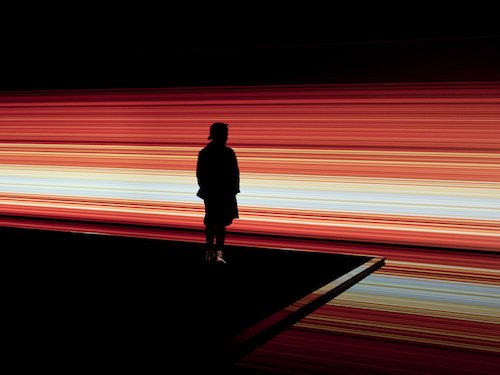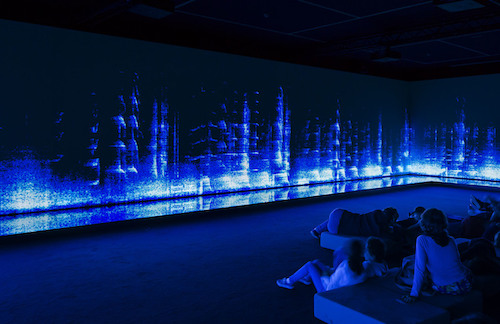Great Animal Orchestra
 Sunday, August 6, 2017 at 11:03 tagged
Sunday, August 6, 2017 at 11:03 tagged  anthroposcene,
anthroposcene,  ecology,
ecology,  nature,
nature,  soundscape
soundscape 

 Sunday, August 6, 2017 at 11:03 tagged
Sunday, August 6, 2017 at 11:03 tagged  anthroposcene,
anthroposcene,  ecology,
ecology,  nature,
nature,  soundscape
soundscape 

 Monday, January 23, 2017 at 10:28 tagged
Monday, January 23, 2017 at 10:28 tagged  glass,
glass,  installations,
installations,  magnetic,
magnetic,  nature,
nature,  physical
physical Since ancient times, Japanese people have been sensitive to perceive nature as it is, from the sound of the wind through pine trees or the singing of insects in each season. ‘Chijikinkutsu’ was developed with this kind of delicate sense. - Nelo Akamatsu

Nelo Akamatsu is a Japanese multidisciplinary artist. “Chijikinkutsu”, the title of his latest work, is a contraction of the words “Chijiki” and “Suikinkutsu”. The first meaning “geomagnetism” and the latter is the word for a sound installation ornament for traditional Japanese gardens, invented in the 16th century.

In “Chijikinkutsu”, sewing needles are floating on water in glass tumblers which are magnetized, so they are affected by geomagnetism and turn like a compass. When electricity is applied to the coil which is on the outside of the glass tumbler, it creates a temporary magnetic field drawing the needle to the coil. The needle hits the glass creating a very delicate sound.
“A round surface of water in the glass with a floating magnetized needle, reminds me somewhat of a tiny earth with geomagnetism. The smaller the sounds of the glasses will be, the more keenly viewers’ sensibility will be sharpened. In the meantime, they realize that the sounds don’t come from outside of their bodies, but already exist inside of their mind.” - Nelo Akamatsu
I love the minimalist approach of only using a few elements and letting the complexity emerge from having multiple instances. Also, where most sound art is often very “visual” in simply showing the elements that the installation experience exists of (the speakers, the wire, the sensors), this work does not show the regular elements but maybe an even more stripped version of it. A speaker is also a coil being pushed and pulled, it also works with electromagnetism. In that sense, Akamatsu’s work is a very, very rudimentary work of sound art.
Christian Skjødt is a Danish artist and composer exploring temporal, spatial, as well as physical aspects of sound and aesthetics of noise. His installation works are often site-specific and include self-built electronics. Which is the case as well for his Illumination (2014): A site-specific piece for a 18th-century wine cellar in the Botanical Garden in Riga.

Illumination examines the translation of the outer circumstances, harvesting the energy from the sun, and bringing this into the cellar in the form of sound. In the cellar the sounds are spatialised, and the particular acoustics of the dome-shaped cellar are investigated.

Each circuit/speaker is tuned to 440 Hz when it’s receiving optimal sunlight. When it’s receiving less than optimal sunlight, the perfect pitch is distorted, resulting in a microtonal cluster-type of texture due to weather conditions and the rotation of the planet.
Christian Skjødt - Illumination from Christian Skjødt on Vimeo.

Berlin Based composer and sound artist Andreas Bick made underwater recordings of a frozen lake near Berlin. It is a wonderfully clear recording, made with underwater microphones placed directly under the ice sheet.
It reveals some haunting sounds we will never be able to hear live. If you would not know the source you would probably not guess these sounds are made by frozen water. Visit Andreas' blog Silent Listening and listen to his recordings!
 Thursday, November 5, 2009 at 17:18 tagged
Thursday, November 5, 2009 at 17:18 tagged  nature,
nature,  performance
performance Wouldn't it be wonderful to cruise the beautiful Swedish landscape, stop for a while to stretch your legs and then hear the screeching sound of Harvest, combined with the surreal image of a well dressed church choir playing the soil like it's a record.
Harvest is a performance "for terrafon, traditional music ensemble and cropland", created by the people behind Bacterial Orchestra, Olle Cornéer and Martin Lübcke. Only this time there are no electronics involved, only old iron, the soil of Uppland and human power. We listen to what the earth has to say.
 admin
admin
Olle Cornéer sent me an email to tell me there actually are electronics involved. Namely a loudspeaker and amplifier in the cone. The signal is even running through a computer for some eq as well as recording the direct signal. Thank you Olle!

I was reading this month's edition of Wired magazine when I came across this article. To keep a swarm of Asian carp from invading the Illinois River and disturbing the native fish, ecologist Greg Sass is experimenting with 'noisy bubbles'.
By using air bubbles combined with high, chirping sounds, the carp invasion is stopped. Carp can hear sounds up to 2kHz, frequencies the native fish can't hear. A curtain of bubbles and noise creates a loud 'wall of sound'. Sound in a bubble-water mixture can become extremely loud.
I never heard of such a 'bio acoustic fish fence', and one might question if we should interfere with nature at this level, but the idea of using the sensitivity of a certain species' hearing combined with the known properties of sound is at least thought provoking.
Sound is used in so many clever ways in this world, in places we don't know about. It makes me wonder what other purposes sound can have, in a completely functional, un-aesthetic manner. It's fascinating to discover what we can do with sound, and how it can help us in this world.
Do you know of any interesting, strange, unconventional ways of using sound? I'd be happy to hear.
Picture by The Artifex
Last week I experienced two completely different soundscapes. First it was Queensday in Amsterdam, which means a whole day of loud music, masses on the streets, shouting children, overdriven speakers and boat horns. A day on which my head had to stand a lot of sonic pressure.

I spent the weekend in a forest in Belgium, with no one around except for a casual walker, enjoying the oxygen-filled forest air in spring. A complete opposite of the screaming city soundscape I experienced two days before.
I need silence at times. After a long day of teaching, traveling or working on a sound design project I don’t switch on my stereo when I get home to listen to some new music. It’s like I can only handle a certain amount of sound a day, next to the fact that I don’t like to just play some music without being able to really pay attention to it.
Sitting on a grass field in the forest I was surprised though by what I heard. It wasn’t that quiet at all.